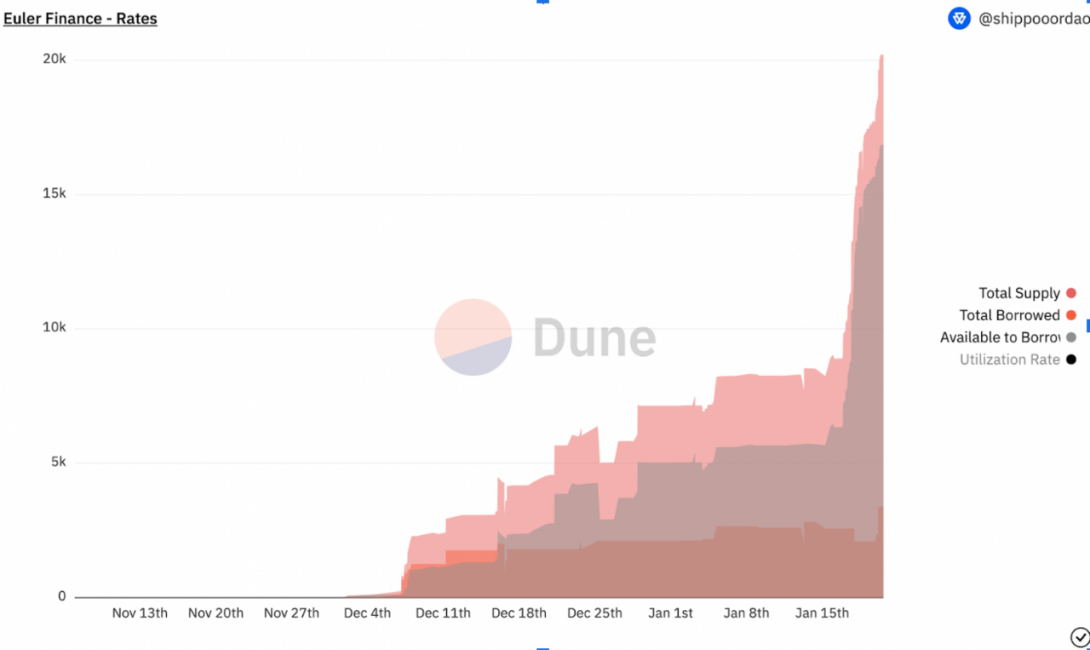More and more DeFi Protocols have begun supporting LSDs to offer a more flexible way to stake and earn.
The popularity of liquid staking derivatives (LSDs) has increased significantly in recent months resulting in a surge in cash flow in DeFi. LSDs are a relatively new type of token that enables stakers to augment potential returns by unlocking liquidity for their staked cryptocurrency, such as ETH.
LSDs have been exploding in popularity across the Ethereum ecosystem and have the potential to become equally as widespread among other Layer-1 networks, such as Polygon and Avalanche.
LSDs are already playing a significant role in DeFi, making up over 20% of the entire TVL across liquid staking protocols. The dominance of Lido alone — currently the largest liquid staking protocol — is over 17% of DeFi’s TVL as of February 2023.
LSDs may have jump-started a strong rebound in DeFi activity, as the trend is likely to accelerate with the deployment of the Shanghai upgrade, which is expected to attract more stakers and thus boost demand for LSDs.
How do LSDs stimulate DeFi activity?
LSDs grabbed the attention of DeFi users after Ethereum adopted the proof-of-stake (PoS) consensus algorithm, which replaces mining with staking. ETH holders can now stake their tokens to maintain the network and generate an annual yield.
However, two conditions limit access to staking for regular token holders. First, there is a minimum deposit limit of 32 Ether to join the block validation battle. Second, the staked ETH remains located on the Beacon Chain until the Shanghai Ethereum update is completed, and even then, rewards will gradually become available.
Liquid staking protocols solve the first problem by pooling ETH from multiple holders to facilitate participation in Ethereum’s block validation process. Thus, protocols such as Lido, enable ETH holders to stake without having to run a validator node.
Liquid staking protocols not only enable fractional deposits in their staking pools but also offer stakers derivative tokens based on a 1:1 ratio in the form of liquid staking derivatives (LSDs).
Stakers can use these LSD tokens in the broader DeFi market to leverage yield opportunities. Thanks to LSD tokens, stakers can multiply the benefits from their locked tokens, which otherwise would only generate staking rewards.
How to put LSDs to work?
Stakers that utilize LSDs can leverage various yield opportunities in the fast-growing DeFi space. For example, they can pursue generous yield opportunities on lending platforms by depositing their derivative tokens or using them as collateral to borrow assets for further market activities.
Several DeFi lending protocols have integrated LSDs into collateral markets. Among them is Euler Finance. This Ethereum-based non-custodial lending protocol allows users to lend and borrow several LSDs, such as cbETH and stETH, derivatives that are facilitated by Lido and Coinbase.
Recently, Euler added support for cbETH, the LSD token issued by Coinbase to ETH stakers who choose to stake with the exchange. Prior to the listing, cbETH holders couldn’t leverage their collateral to facilitate other market opportunities. After launching support for this derivative, Euler attracted about $29 million in this asset alone, demonstrating the tremendous potential of LSDs in DeFi.
Seraphim Czecker, Head of Risk at Euler Labs commented:
“The fact that supplied cbETH on Euler exceeded grew so rapidly overnight after being promoted to collateral tier suggests wide appetite across retail and funds alike to trade LSD products beyond just Lido’s staked ETH. With more than a billion in mintable cbETH, this market is bound to expand as DeFi traders use Euler to earn additional yield on cbETH or lever up on staking rewards.”

LSDs’ market share in DeFi may surge
The DeFi boom back in 2020 wouldn’t have been possible without stablecoins, which accounted for over 30% of the entire DeFi market at their peak. LSDs can have a similar impact thanks to their unique ability to enhance staking benefits.
According to Staking Rewards, the percentage of staked Ethereum is only 14%, which is very low compared to Cardano’s 71%, Avalanche’s more than 62%, and Polygon’s nearly 40%. One of the reasons why ETH holders are still hesitant to stake has to do with the restrictive condition of locking the ETH tokens when staking.
There is good news, though. The upcoming Shanghai upgrade will include a code, referred to as EIP 4895, which will enable staked ETH withdrawals. The upgrade will allow a 1:1 exchange of Beacon Chain staked ETH for ETH. This will encourage more ETH to be staked through liquid staking pools, which would drive demand for LSDs and potentially trigger rapid growth in DeFi TVL.
Eventually, other blockchains, such as Polygon and Avalanche, can benefit from their own LSDs, which would help them compete with Ethereum and contribute to a healthy balance across the DeFi space.
Source: https://cointelegraph.com/news/defis-next-big-thing-liquid-staking-derivatives



